If you live anywhere in the South, you’ve likely heard the old joke that says “whenever someone dies, they don’t go to heaven (or that other place), without connecting in Atlanta!”
Having spent 14 years living in various southern cities and connected through Atlanta more times than I care to remember, there’s no doubt the scene at Hartsfield-Jackson International Airport (ATL) the other weekend is one that won’t soon be forgotten.
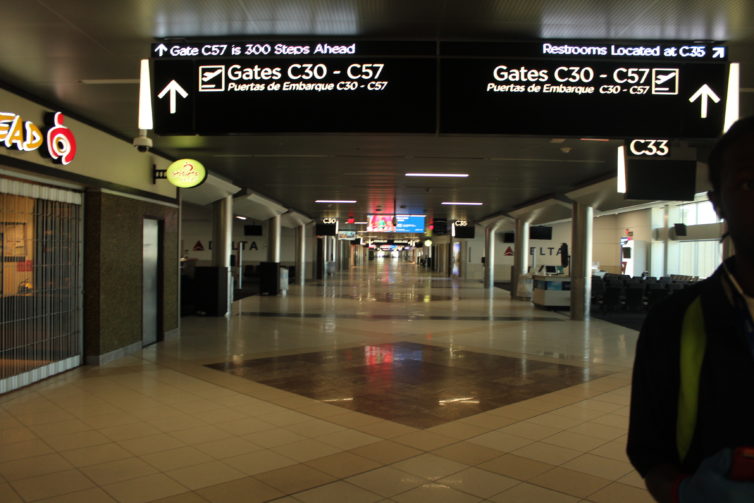
A peak into an empty “C” gates at ATL, thanks to an airport worker who allowed this pic while the door for employees was open.
Recently, I needed to take a number of flights for family reasons, and in the current coronavirus climate, I wasn’t sure what to expect. My adventure took me through one Delta mega-hub (Atlanta ATL) to another (Minneapolis MSP), where typically the flights would be full. However, this time they were only about 25 percent occupied. The ATL to MSP flight, usually an A321 or 757, had been replaced by a smaller 737-800.
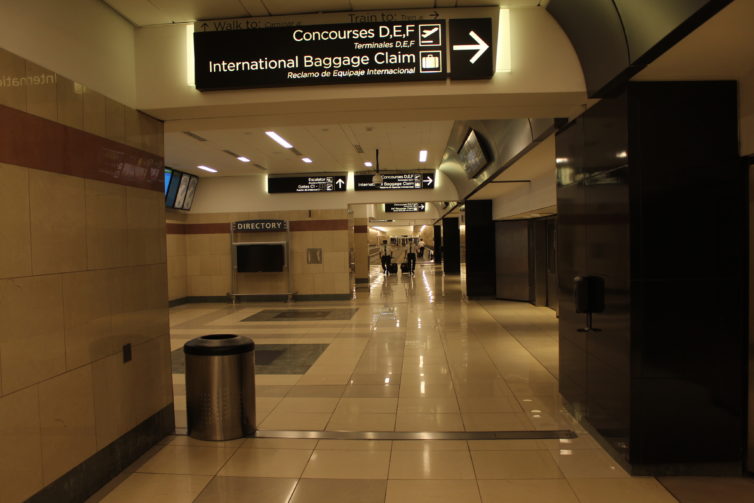
No passengers and just 2 pilots occupy the “Plane Train” level at ATL below the C gates.
Atlanta currently has multiple concourses closed with fully sheetrocked walls and security doors to allow only airport and airline staff to enter. The ’œC’ and ’œE’ terminals were just empty shells. TV screens packed with flight info now had just a couple active monitors.
BONUS: Feeling the impact of COVID-19 on the US Commercial Airline Industry
The food court in the E terminal had just one restaurant open: McDonald’s. They were so happy to see anyone that they gave me 10% off my McDouble — that 20 cents will go far someday, I just know it! You know it’s bad when even airport concessions start discounting prices.
This post is written by aviation and photography enthusiast Drew Vane about the MD-80:
Ahhh. I remember the good ole days when the aircraft were loud, smoked like a B-52 and fuel efficiency was unheard of. No, I’m not talking about the 60’s. I’m talking about yesterday.
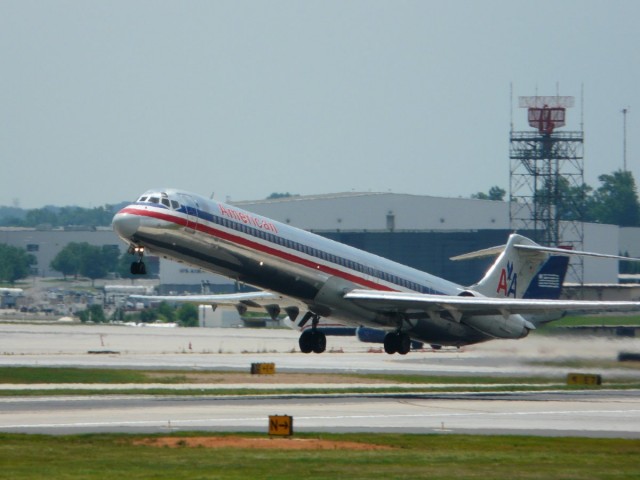
An American Airlines MD-83 (Super 80) lifts off of Runway 36C at Charlotte-Douglas International Airport.
As commercial aircraft manufacturers transitioned from props to jets, Douglas Aircraft Corporation developed a smaller jet aircraft for the shorter range domestic market. The 90seat DC-9 first flew in 1965 and gave birth to additional series, culminating with the 50-series under the original DC-9 design. McDonnell-Douglas introduced its newest, longer version of the DC-9, fondly called the DC-9 Super 80, or MD-80. This 142-seat product of Long Beach, CA got its start with PSA Airlines (eventually to become US Airways). The MD-80 added 15 feet in length and 20 feet in wingspan, resulting in an additional 28 seats to the 139-seat DC-9-50.
Similarly, the MD-80 family (also called the ’œMad Dogs’) has improved with each subsequent version. The MD-88 added aerodynamic improvements for longer range, a redesigned tail-cone, and glass cockpit. The MD-90 upgrade increased capacity to 150 passengers and replaced the Pratt & Whitney JT8D engines with quieter, more fuel efficient IAE V2500 engines. Following the merger of McDonnell-Douglas with Boeing in 1997, a further upgrade, the MD-95, was born which eventually became the 117 seat Boeing 717. The 717 added a more advanced cockpit, more efficient engines, fly-by wire controls, and other features to bring it into the 90’s and beyond. Strangely, the AFC (or Advanced Common Flightdeck) most closely resembles that of the massive MD-11. Over 2,400 DC-9 series aircraft have been produced over the last 40 years.
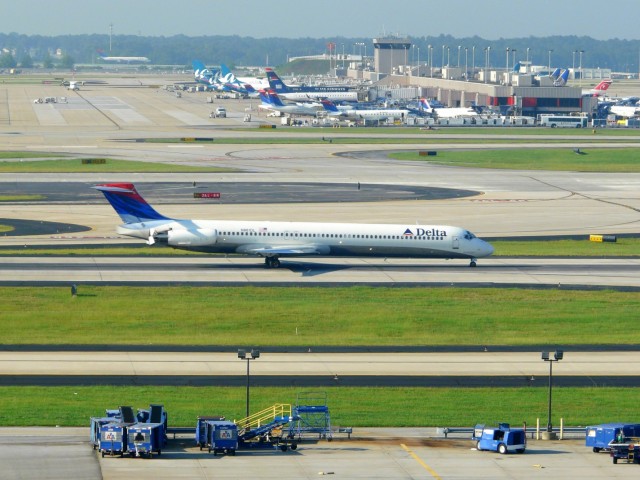
Look Ma! No Rabies! A Delta Air lines MD-88 slows after landing at Atlanta’s Hartsfield International Airport
Although the seating configuration is a bit skewed (2-3), today you’ll still find these workhorses on domestic routes for Delta, American and Allegiant here in the US. The Boeing 717 is flown in the US by AirTran (soon to be Southwest) and Hawaiian Airlines. As of midway through 2010, there were over 450 Mad Dogs still flying here in the US with 100 or so still active in other countries.
Its been a long time since my last Mad Dog flight but I was pleasantly surprised last November when I flew with my family on an AirTran Boeing 717 down to Florida. The holidays brought free WiFi and the aircraft just felt newer compared to my memories of the Mad Dogs. Here in Charlotte, there are ample opportunities to spot the Airtran 717’s and Delta MD-88’s bound for Atlanta as well as the fully loaded American Super-80 bound for Fort Worth that seems to use every inch of the runway on taking off.
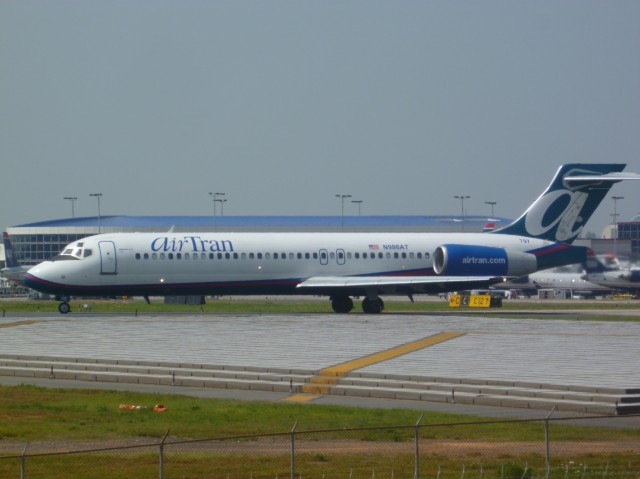
Mad Dog Wannabe: An AirTran Boeing 717 taxis onto Runway 18L at Charlotte Douglas International Airport.
Unfortunately, the sun is slowly setting on these older aircraft as more eco-friendly, and efficient domestic jets continue to enter the market. American recently announced its plan to replace its fleet of MD-83’s (in addition to its 757’s and 767’s) with re-engined Boeing 737 and Airbus A320neo jets and its expected that Delta will follow in its footsteps to stay competitive. Have you had the opportunity to ride on these gas guzzlers lately? I’d love to hear about your experience.
More info on the background of the MD-80 here and MD-90 here.
All photos by Andrew Vane
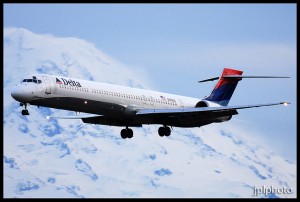
Delta Air Lines MD-90 (N908DA) in older livery with Mt. Rainier in the background.
Delta Air Lines has a very diverse fleet of aircraft. Delta currently flies the Boeing 737-700 and -800, the Airbus A319 and A320, the DC-9, MD-88 and has been adding additional MD-90s — which all compete with each other. A while back Delta announced they would be replacing their older DC-9s with newer aircraft and at first I assumed it might be with Boeing 737s and Airbus A320s in a move to simplify their fleet by getting rid of the entire DC-9/MD-80 family, but it looks like they are going to upgrade it. Why would Delta buy MD-90s instead of Boeing 737s or Airbus A320s? I think there are a few reasons.
The biggest is cost. To pick up a Boeing 737 or Airbus A320 it is going to cost a heck of a lot more than purchasing a used MD-90. Yes, Delta will have to pay to re-do the interiors and the planes won’t be as fuel efficient as a brand new model, but the over all costs will still remain lower. Delta has a huge maintenance facility in Atlanta and would most likely continue to work on DC-9/MD-80 aircraft from other airlines, even if they got rid of their own fleet.
The MD-90s allows Delta to back fill the DC-9s and save additional time before completing an entire fleet renewal program. Delta just announced buying nine MD-90s from Japan Airlines (JAL) and they hope to find more in the future. Delta’s President Ed Bastian stated at a December investor presentation that Delta hopes to purchase about 50 MD-90 aircraft over the next two years.
Since Delta is looking to get so many MD-90 aircraft, could it make sense to purchase some Boeing 717s which are based off the MD-90? Maybe. Recently Southwest purchased AirTran, which has over 85 Boeing 717s. Currently, Southwest only has a fleet of Boeing 737s, it could be possibly they would want to be rid of the 717s. The problem is that Southwest is locked into a contract with Boeing for the aircraft and it is unlikely Boeing would want to let them out. If Delta plans to purchase a significant amount of new Boeing aircraft in the future, it could be negotiated to let Southwest out of their contract early (with Southwest’s approval, of course), allowing Delta to take control of the 717s.
“The MD-90 is a cost-effective aircraft that helps us more efficiently maintain our flying levels as we retire regional jets and DC-9s, so the additions won’t increase our capacity.” Delta spokesperson Trebor Banstetter told AirlineReporter.com. “We’ll continue to look for opportunities to acquire used MD-90s in the future as we retire DC-9s and smaller jets.”
Either way, I like the ‘ol MD-80 maddog family. I hear so many people complain about the aircraft and sure if you are sitting in the back by the engines, they can be a bit annoying. However, I love that 2-3 layout and the sound of their engines at full throttle during takeoff. I am glad to see an American airline will be keeping the maddog alive for years to come.
Image: Jeremy Dwyer-Lindgren





